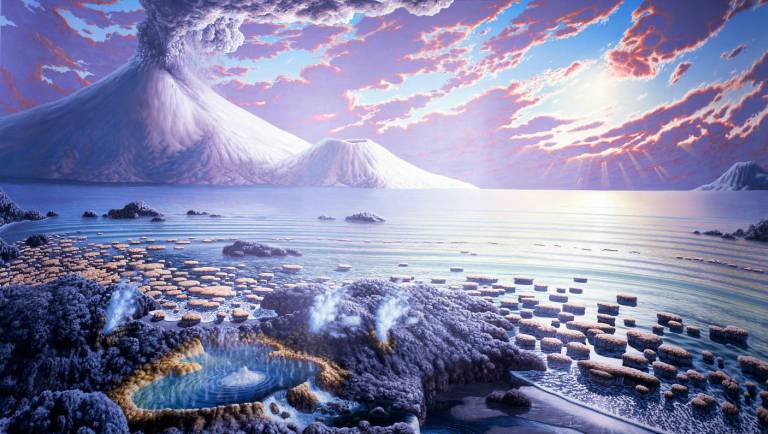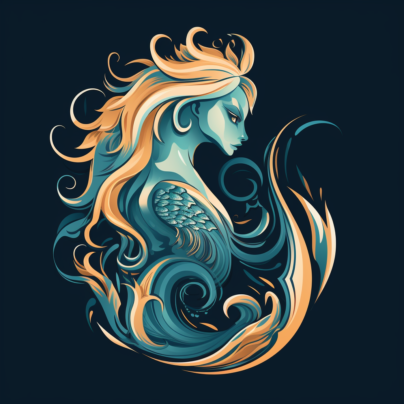The Dawn of Earth
“The Dawn of Earth — When fire met stone and the stars gave birth to a world.”
Eon XXIII – The Age of Elementals
“The world breathes — and its breath takes shape.”
As Earth’s molten crust solidified and its atmosphere began to stabilize, the planet’s primal energies coalesced into sentient forms. From the churning seas, smoldering volcanoes, and roaring winds emerged the Elementals—titanic beings embodying the fundamental forces of nature.
Each Elemental was a manifestation of its domain: the Pyroclast danced atop volcanic spires; the Tidelord whispered to the crescent moons, orchestrating the tides; the Cloudfather’s breath sculpted the seasons; and the Lithomothers molded valleys and mountains with deliberate grace.
These entities did not think as mortals do. Their consciousness was cyclical, their conflicts expressions of natural balance. Storms were their debates; earthquakes, their lamentations. Through their interactions, the laws of physics—gravity, thermodynamics, erosion—were inscribed upon the world.
Amidst this elemental awakening, a cosmic event unfolded. As the Earth cooled, the Great Old One Cthugha, a colossal entity of living flame, descended upon the nascent planet. Accompanying Cthugha were its servitors, the fire vampires—fiery beings that ignited everything they touched. Their arrival marked the first incursion of extraterrestrial life upon Earth, introducing alien fire into the planet’s elemental tapestry .
The fire vampires, extensions of Cthugha’s will, interacted with the native Elementals, their presence influencing the balance of elemental forces. Some Elementals absorbed this new fiery essence, evolving in form and function, while others retreated into the Earth’s depths or dissipated into their respective elements.
As the Age of Elementals waned, their colossal forms gave way to the rise of smaller, more adaptable life forms. Yet, the legacy of both the Elementals and the fiery interlopers endured, etched into the planet’s geology and mythos. Volcanoes, wildfires, and storms became the lingering whispers of their ancient presence, reminding all of the time when the world itself was alive with elemental consciousness.
Eon XXIII – Dawn of Life (Age of Aberrations)
“First whispers of life—and first nightmares—stirred beneath the waves.”
In the black-mouth trenches of the young sea and in scalding pools of volcanic glass, something impossible awakened. No creatures crawled or swam at first—only shadowy forms of living flesh and stone, maddened by chance and cosmic fury.
The First Aberrations

Chains of rogue molecules coalesced into writhing masses, ancestors of true monsters. Some looked like tangled clusters of eyes and tendrils, gibbering into the dark—Hungry Aberrations later known as Gibbering Mouthers, whose chattering cries echoed through sulfurous currents. Others took solid shape: squat, armored carapaces plated with living quartz, possibly early cousins of umber hulks or other deep-earth horrors, shuffling across the seabed in search of geothermal heat.
These early aberrations were neither elegant nor stable. They grew by consuming raw minerals, then split themselves in unholy division. Each spawn mutated wildly—some bursting into nightmares of razor-tipped limbs, others glowing with alien phosphors. In this primal soup, replication was chaos made flesh.
The Far Realm’s Influence
Beyond the bounds of time and reality lies the Far Realm—a dimension of madness and abstraction where logic dissolves and chaos reigns. It is from this incomprehensible plane that many early aberrations are believed to have originated.
Creatures from the Far Realm beheld the barren Earth and crossed over, drawn to its primal instability. Among them came Aboleths, vast psychic leviathans whose memories stretched back to other stars; Beholders, hateful floating orbs of arcane vision; Cloakers, shadowy predators with shrieking mimicry; Neothelids, massive worm-like minds that devoured both flesh and thought; Grell, floating brains trailing paralytic tendrils; and Intellect Devourers, who walked in stolen bodies, feasting on thought.
The Cosmic Seedlings
In that swirling crucible of life and madness, cosmic forces began to stir. Among them were beings beyond even aberrant taxonomy—Tsathoggua, the Sleeper of N’kai, who tunneled from void to core and burrowed deep beneath the crust to dream in darkness, an ancient god of sleep, sloth, and secrets; and Yidhra, the ever-shifting mother of mutation, born with the first molecular bonds, spreading endlessly as her tendrils coiled through every living aberration—a goddess of continuity through change.
These entities shaped the fate of aberrations, guiding their monstrous evolution through nightmare and dream. As the veil between realities thinned and thickened in waves, the Far Realm’s corruption echoed in the unstable genetics of Earth’s first life—madness entwined with existence from the very beginning.
The Chaotic Crucible
No ecosystems existed—only unending mutation. Vents belched scalding gas. Tides boiled. Lightning clawed across a roiling sky. Amid this frenzy, aberrations multiplied.
Whole fields of neothelid spawn sprouted from black vents, their writhing bodies clattering like miniature hail. The chaotic tide selected only for survival. The most adaptable and unstable spawned the progenitors of horrors yet to come.
Retreat and Dormancy
As the world cooled and strange new life took hold, the Earth became a harsher place for the aberrations. Many slipped back through cracks between realities, fleeing to the Far Realm’s endless madness. Others burrowed deep beneath the surface, sinking into long slumbers beneath stone, ash, and ice. Timeless and patient, they waited—undying and unseen.
The End of the Age of Aberrations
The Age of Aberrations came to an end as mighty forces reshaped the planet. Frozen storms swept across the world, burying the land beneath endless ice. Great continents tore themselves apart and new lands rose, shifting the seas and skies. Fires from the earth’s depths scorched the surface, wiping away the fragile, chaotic life clinging to existence.
With these cataclysms, the wild chaos that birthed life began to settle. The aberrations receded into shadow and silence, slipping into myth and nightmare. Yet their presence lingers—etched into stone, tangled in the threads of life, whispered in the darkest corners of forgotten dreams.
And when the time comes, they will rise again.
Eon XXIV – Age of Slime
“Life, once ruled by mutation and madness, turned toward stability.”
The Age of Slime dawned in the shadow of aberration’s chaos. As the wild tumult of the previous eon faded, a slow and creeping order began to take hold in the warm shallows. Life—once a riot of mutation and madness—now turned toward stability. Slime ruled the seas.
But these were no mere slicks. Vast, sentient mosaics of microbes—oozing colonies woven from layers of proto-cells, some feeding on light, others scavenging in darkness—spread across ocean floors and clung to rocky shores. They digested minerals, breathed out a strange new breath: oxygen.
At first, this gift turned poison. The atmosphere hissed with chemical fury, iron-rich waters rusted to blood-red, and entire swaths of anaerobic life choked and died. Yet the slime endured.
From these living mats came the first whispers of intelligence—primordial oozes stretching pseudopods, breaking free into gelatinous hunters. Not yet monsters, but the ancestors of future horrors like Black Puddings and Gray Oozes. Semi-sentient scavengers, shaped by eons of digesting death and stone.
In the darkest pits of this living slime stirred a terrible presence. Juiblex, the formless hunger, not yet a demon-lord but a burgeoning god of filth, slithered through the ooze. Where Juiblex passed, lesser slimes gathered as worshippers to a fetid altar.
Across the seas, towering stromatolites—stone mounds secreted by slime—rose like submerged fortresses. These living oxygen factories purified the sky, clearing the air and cooling the seas. The endless storms of lightning faded, and the planet slowly began to breathe anew.
The Breath of Ruin
When the very air turned against its creators.
But this breath was a curse as well as a gift. The Age of Slime’s reign ended in bitter ice and suffocating poison. As oxygen flooded the atmosphere and temperatures plummeted, vast frozen storms gripped the world. The fragile ooze-dwellers and Juiblex’s foul progeny were forced to retreat deep beneath the earth, burrowing into dark caves, buried beneath stone, ash, and ice to survive the relentless cold and toxic air.
During this turbulent time, the great supercontinents rose and fell, the first multicellular creatures emerged, and primitive animals took their first uncertain steps. Chaugnar Faugn incarnated in a grotesque form, shaping its evolution across the eons. Juiblex spread its vile influence across the ancient landmasses, claiming its fetid domain beneath the surface.
Alien intelligences soon arrived. The Elder Things founded their first city beneath frozen Antarctic seas, crafting the proto-shoggoth—perhaps the spawn of Ubbo-Sathla—and an army of servitors. Their cities spread beneath the waves and onto the land.
The Flying Polyps followed, erecting basalt towers and waging a bitter war against the Elder Things for dominion over sea and sky. Though the Elder Things prevailed, the world was forever changed.
Thus closed the Age of Slime—not in silence, but transformation. The oozes and their dark gods withdrew beneath stone and ice, retreating into the shadowy underworld as the surface world grew harsh and cold. Yet the legacy of slime endured—in every breath of air, in every living cell, and in the lurking hunger beneath the earth.
A new age was coming. One of sentience, struggle, and shadow. And it would be kind.
Eon XXV – Age of Pulsing Light
“In the still waters, nerve and mind began to stir.”
As the great slime colonies retreated into stone and shadow, and the icy grip of the catastrophe loosened, something new floated into being. Light filtered through shallow, oxygen-rich seas—and life responded.
Jellyfish-like creatures pulsed gently through the waters, sensing the world with rudimentary nerves. As they exploded in number, they filled the primordial oceans with radiant bioluminescence, casting shimmering veils into every current. This light, pure and strange, was more than illumination—it was a cleansing flame. The elder aberrations and oozes, born of shadow, chaos, and hunger, recoiled from its brilliance, driven into the trenches, the crust, and the rifts between worlds.
In the deeper currents, something stranger awakened.
The Flumphs arrived as outcasts—exiled from the Far Realm not for weakness, but for mercy. Born amid unthinkable geometries and psionic warfare, they had rejected the madness that spawned them. Where other aberrations consumed thought and spread entropy, the Flumphs chose harmony. Their refusal was seen as heresy. Cast into this world like spores on the tide, they did not crash, but settled.
Drifting into the primordial oceans, they became something new. Soft-bodied, glowing with inner light, they floated through psychic debris and sang it into peace. They absorbed fear, pain, and stray whispers of the Far Realm’s distant scream—and gave back only silence.
In the early calm of this eon, the seas knew no hunger. The Flumphs, gentle and tragic, pulsed in slow formations, communicating in colored waves and harmonic vibration. They herded jellyfish not as livestock, but as companions—drifters bound by shared exile and light.
Together, they lit the oceans with radiant psionics and living glow—a luminous sanctuary against the shadows below. For a time, the world was song.
But peace is a shallow tide.
As more complex forms emerged—life honed by chance and driven by need—the still waters grew restless. New creatures with mouths and motive carved paths through the glow. Jellyfish responded first, evolving stingers and reflex. The Flumphs did not. They would not. They sang as the waters darkened, until the first predators began to hunt by light.
They retreated—some to the abyssal deep, others to hidden fissures of the mind, slipping into psionic dimensions beyond reach. Their harmonies faded from the upper seas, remembered only in the shimmer of bioluminescence.
But in the trenches where light failed, other minds watched.
The Aboleths, ancient beyond the birth of stars, endured in the deep. Neither driven off nor extinguished, they recoiled, coiled, and planned. Where the Flumphs sang in sorrow, the Aboleths whispered in schemes. Slowly, patiently, they seeded the waters with dreams and instincts—nudges toward hunger, form, and control. They were not creators, but conductors—guiding evolution with the precision of a scalpel.
Where aboleths schemed and mind flayers fed, the Flumphs glowed like lost stars—drifting, watching, mourning.
The Age of Light dimmed, pierced by purpose and predation. What followed would not drift—it would hunt.
Eon XXVI – Age of the Primordial Hunters
“Where light once spread, hunger now awoke.”
From hushed depths came the first stirrings of life with form and purpose. Silently, creatures of flesh and mind drifted into being, their bodies shaped by unseen currents and unspoken designs.
Out of the ancient ooze rose warriors of the sea—soft skin turned to scale, fragile limbs to fins. Silent hunters learned to see and grasp, their mouths opening on instinct alone, honed by the endless need to survive.
Beasts—early creatures with breath and hunger—already reigned in the shallows. Armored things scuttled across seafloor silt, spiral-shells drifted in sediment, and worm-things burrowed into soft muck in search of prey. Trilobites, Opabinia, Anomalocaris, and Hallucigenia haunted the depths—chitin-clad, many-eyed, claw-snouted, and spined like riddles in motion. Though strange, they ruled their domains with cunning and alien grace. These were not yet monsters, but they were ancestors to all that would come.
Gastropods, armored with spiraled shells, carved glittering trails across the seabed—shimmering remnants of the first attempts at protection. In shadowed trenches, stranger forms appeared. Stories speak of colossal snails with crystalline flails and slugs so vast they shaped the seafloor with each ripple. Whether real or myth, their memory lingers in fossil spirals like buried warnings.
Yet it was the Great Fishes—behemoths of scale and sinew—that cast their shadows across every wave. Jawless titans glided among the reefs, armored and swift, driven by an ancient purpose. They scraped rock and bone with toothless mouths and shimmered with cold grace. In their wake came legends whispered by those who followed.
Beneath them, the seabed was carpeted in dark Oozes—vast, creeping mats of ancient muck. Though not slimes in the arcane sense, these thick blankets formed living labyrinths that trapped, fed, and nurtured. Here, life fed life in silence.
And deeper still, the Aboleths moved.
Invisible to the surface world, they wove thought into instinct, pressing their will into the tide. They did not build cities or wage wars. They dreamed around others—subtly, insistently, rewriting futures in the dark. The rise of the hunters was not their invention, but their direction. Where light once meant sanctuary, it now lured prey.
Beyond the reefs, something wondrous stirred. In hidden hollows, vast living minds—mute and alien—stretched neural tendrils through the water. They glowed with silent understanding and wove the currents into shapes of power. Though they built no grand cities, their awakening was the first spark of sea-borne thought. Some spoke in pulses of light, others in tremors and song. A few began shaping the waters themselves—into lenses, veils, and barriers.
On the surface, the air grew sweet with promise, and below, the dance of predator and prey quickened. Armor gave way to cunning, speed to craft, and every new gift carried the weight of destiny.
The Age of the Primordial Hunters was more than a bloom of life—it was the dawn of intent. In those ancient depths, purpose took root, and with it, the first shadows of fear.
But no reign lasts forever—not even one born in the tide. The world shifted. Currents cooled. Shallows fell still. Some say the seas themselves turned on their makers, drowning the old ones in silence. Others whisper that newer, hungrier things emerged—creatures faster, sharper, crueler. The first minds were not slain but out-thought. The great hunters faded, their bones turned to stone, and the tide rolled on to the next age.

 Buy me a coffee
Buy me a coffee